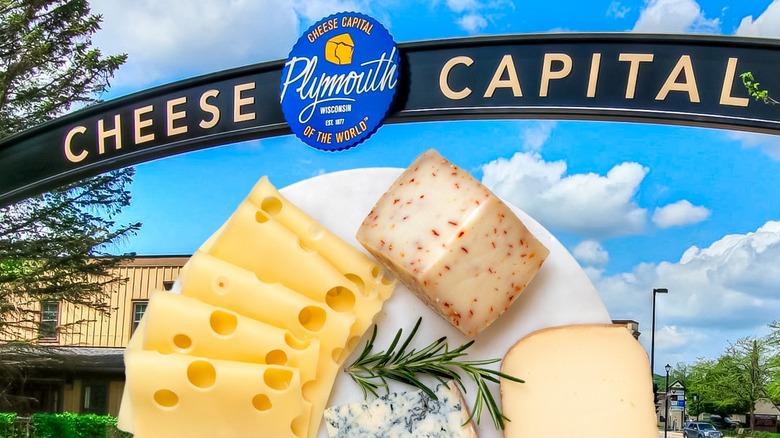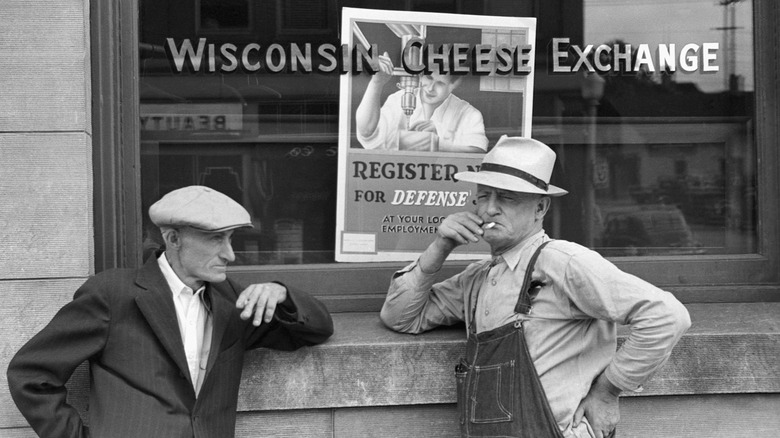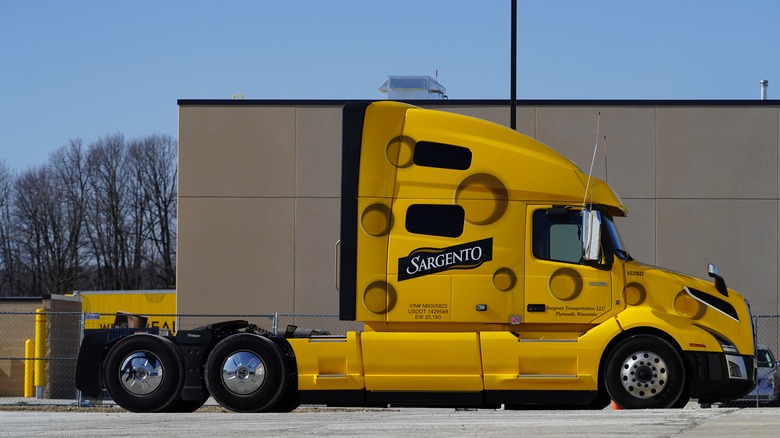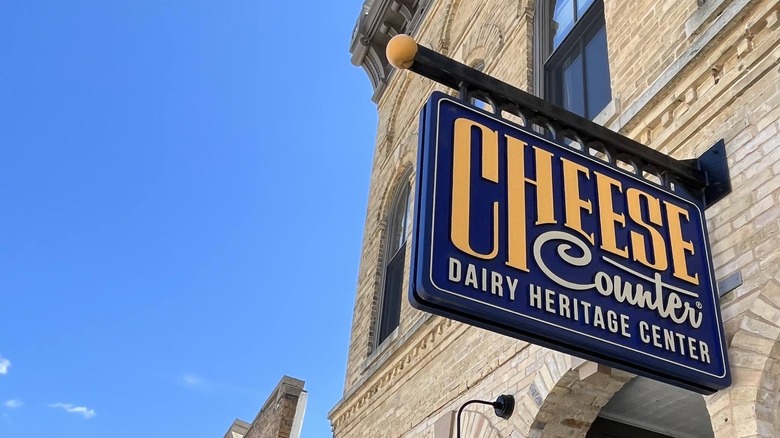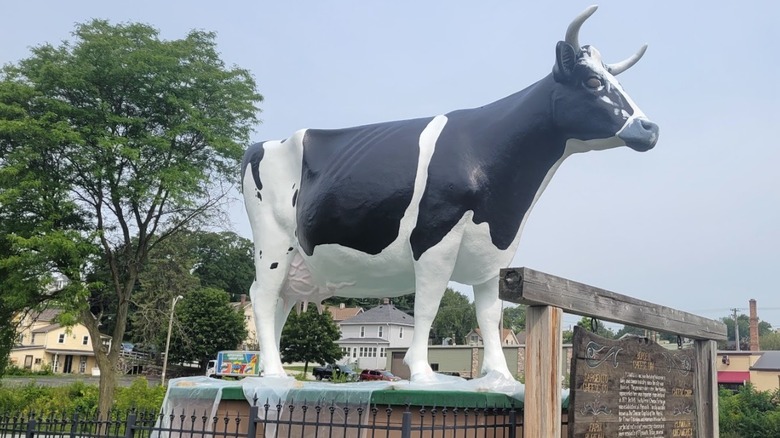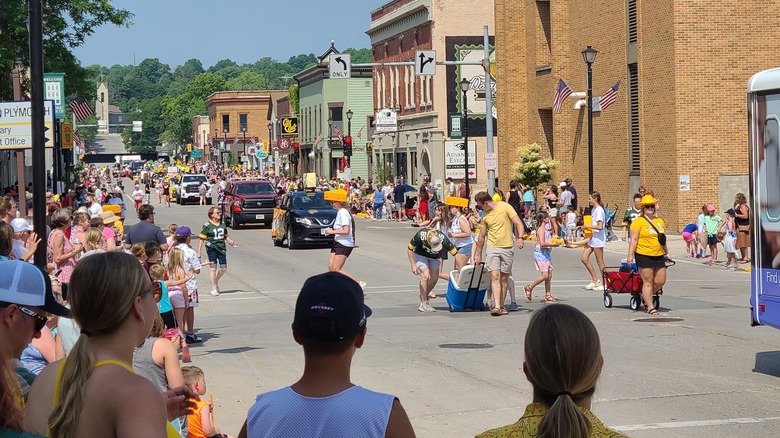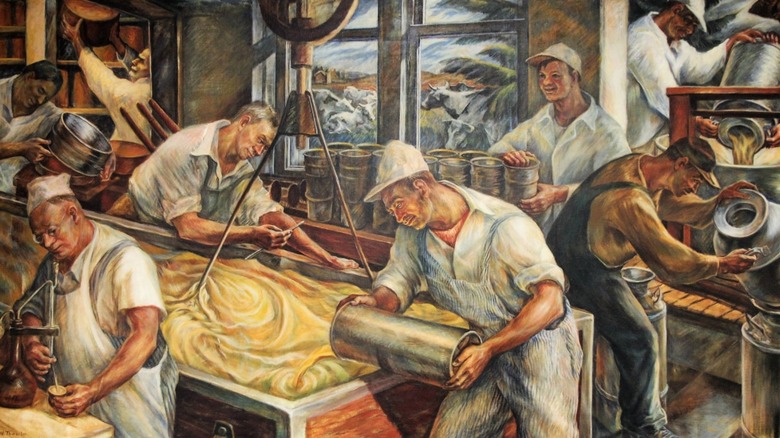Explore The Cheese Capital Of The World In Plymouth, Wisconsin
Many destinations around the world are widely considered culinary capitals, from Naples to Bangkok, and Sydney to Porto. Within the confines of the United States, several cities and towns are currently the epicenters of specific foods and drinks. For instance, Manchester, New Hampshire, is renowned for its scrumptious chicken tenders. Le Mars, Iowa, makes the tastiest ice cream, and New York City has perfected the art of baking bagels. As for the small town of Plymouth (population: 8,897), located in Sheboygan County, Wisconsin, it has apparently earned the title of Cheese Capital of the World, and it seems that it's well-deserved.
Nicknamed America's Dairyland, Wisconsin is famous for many types of cheese, such as the Red Barn Vintage Cupola, Uplands Pleasant Ridge Reserve, and Carr Valley Glacier Penta Crème. Plymouth itself produces 14% of the cheese consumed nationwide. Additionally, it's home to four large artisanal cheese manufacturers and several cheese-centric stores, landmarks, and events. Here are all the reasons why this town is so proud of its agricultural heritage.
History of cheesemaking in Plymouth
An article in Sheboygan Press summarizes the town's cheesemaking milestones. Incorporated in 1877 as Hub City, Plymouth first made a name for itself in the production of bicycles, cigars, beer, furniture, and phonographs. Though it wasn't dubbed the Cheese Capital of the World until well into the 1930s, elaborate cheesemaking had already taken root among the first settlers, when farmwives wouldn't let leftover milk go to waste. The very first cheese company in town was actually established back in 1863 by Hiram Conover, paving the way for many more in the vicinity. It was his son, Seth Conover, who became the first big trader of cheese in the state, thanks to his tireless efforts and connections, not to mention the development of rail lines.
Plymouth became the center of the Wisconsin Cheese Exchange in 1918. The southern part of town, where all the producing, storing, curing, and shipping took place, became known as Cheeseville. The manufacturers operating there included the Phenix Cheese Company, which had bigger branches in NYC and Chicago and produced what is now known as Kraft Philadelphia Original Cream Cheese. Another company, Lakeshire Cheese, revolutionized the pasteurization process by reducing it from 45 minutes to 45 seconds. It wasn't long until the northwestern part of town was also called Cheeseville, but the biggest and most famous cheesemakers still in operation today are presented below.
Sartori Cheese, Sargento Foods, Masters Gallery Food, and Great Lakes Cheese
These are Plymouth's largest cheese manufacturers today. Sartori Cheese, founded in 1939, currently employs 40 licensed cheesemakers and produces many flavors of BellaVitano, cheddar, Parmesan, and Asiago, as well as a range of spreads and dips. On its website, the brand offers ample insight into preparing the perfect charcuterie board with its most popular products. It also suggests pairing its classic cheddar with wine, beer, artisan bread, dried nuts, chocolate, dried fruit, or savory crackers.
Established in 1953, Sargento Foods, for its part, claims to only produce natural cheese, be it sliced, cubed, string, or shredded. Its creations vary from Swiss to cheddar, Jack, ricotta, and mozzarella. Sargento cheeses are apparently best used on pizza and in macaroni and cheese, grilled cheese sandwiches, and charcuterie boards.
As for Masters Gallery Food, which has been around since 1974, it employs 14 licensed cheese graders and can be commissioned for custom blends of cheese. Its products include mild and aged cheddars, Monterey Jack with peppers, provolone, mozzarella, and Asiago.
And finally, Great Lakes Cheese, which dubs itself "the nation's leading natural cheese packager," was founded in 1958. It's currently headquartered in Hiram, Ohio, but owns nine plants across the U.S.; the one in Plymouth dates back to 1982. The brand employs over 4,000 people and has nabbed several American and international awards, thanks to its wide array of flavors and formats of organic, snack, and processed cheeses.
The Cheese Counter and Dairy Heritage Center
Located on Mill Street, the Cheese Counter and Dairy Heritage Center is another unmissable landmark, and it's considered one of the best cheese stores in Plymouth. It sells Wisconsin-made cheeses; fresh cheese curds from local farmers; chocolate, sausage, and maple products; themed magnets, glassware, shirts, and bags; elaborate cheese gift boxes; and snacks to go.
The place also doubles as a restaurant, and its lunch menu includes the signature Triple Cheese Temptation panini; the Meltdown, a grilled aged brick cheese on marble rye bread sandwich that's served with kettle potato chips and a pickle; beer cheese soup; and the Cheese Capital Blend Mac, which incorporates cheddar, black pepper, BellaVitano, Parmesan, and the creamy MontAmore.
The Cheese Counter has earned 5 stars on Yelp, with reviews ranging from "Highly recommend to eat in or get takeout" to "Excellent variety and prices," and "Very impressed with the cheese, the bright vibe, and the amazing people."
Antoinette and the Wisconsin Cheese Exchange
Plymouth's quirkiest roadside attraction and most famous dairy-centric landmark and photo spot can be found at 12 S. Milwaukee St. It's a giant fiberglass Holstein cow statue that weighs 1,000 pounds and stands at 20 feet, pedestal included. First named The Cow, it was inaugurated during the town's centennial celebration in 1977. In 1992, it received a makeover from Milwaukee sculptor, painter, potter, and taxidermist Ernst-Albrecht Gramatzki. For the occasion, the Plymouth Chamber of Commerce held a competition to grant it a more appropriate name. The funniest entries included Bovine Betty, Moo-Moo Moozarella, Moreen Milkicious, and Chedarella, but the statue was eventually rechristened Antoinette to honor Jack Anton, the resident who originally campaigned for its creation.
Not only does Antoinette symbolize Plymouth's dairy heritage, but it was purposely erected at the previous location of the Wisconsin Cheese Exchange, which later became the National Cheese Exchange and relocated to Green Bay in 1956. According to the Journal of Dairy Science, over 14 million pounds of cheddar were sold through the Exchange.
The annual Cheese Capital Festival
Culinary festivals around the world usually render a trip more immersive and enriching, and Plymouth's answer to those crowd-pleasing events is its very own annual, free-access, family-friendly Cheese Capital Festival. Held in June, it calls on attendees to come enjoy the cheese-themed parade and festivities, including a cheese-eating contest, live music, and a foam cheese wedge race in the Mullet River (the winner of the race brings home a grand prize of $1,000). The biggest local cheese manufacturers are also present, hosting cheesemaking, cheese grating, and pairing demonstrations, not to mention all the vendors selling food, beverages, and handicraft items. As for the cheese parade, it's one of the most anticipated events, wherein the locals are invited to participate for free, provided they come up with a cheese-themed float.
There are plenty of activities for children during that festival, too, from face painting to a petting zoo, a farm-themed playground, a mascot corner, and a bounce house. Moreover, they're treated to free milk and fun dairy-themed merchandise.
The Cheese Capital Wine Walk and other events
Plymouth is constantly abuzz with activities, tours, and events that showcase its cheese culture, including farmers' markets, live music, luncheons, fundraisers, and championships. There is even a New Year's Eve Big Cheese Drop at the Plymouth Arts Center, complete with gift bags, cheese tasting, a bonfire, and live music.
The Cheese Capital Wine Walk, held in August, is yet another fun occasion to pair the ideal wines with local cheeses. All attendees receive collectible glasses with their prepaid tickets and use them to sip wine with assorted snacks and charcuterie boards as they hop downtown from one business to another. The participating venues are not necessarily restaurants or bars, though, but mostly shops and clinics that are momentarily transformed into wine-tasting rooms with live acts and discounts. They include a bookstore, the Plymouth Arts Center, and the Plymouth Historical Society.
The Plymouth murals
Plymouth is not only recognized as the Cheese Capital of the world, but also the Mural Capital of Wisconsin. There are currently 30 giant, vintage-looking murals spread across its downtown depicting its history, culinary heritage, important businesses, public institutions, and signature products. Those pieces are integral to Plymouth's identity; most of them were painted in 2011 and touched up in 2021. Therefore, no visit is complete without a classic, self-guided mural walking tour.
As for the cheese and farming-related paintings, they include: "History of Sargento," painted by Ray Guzman and sponsored by Sargento Foods; "Plymouth Post Office," created by Charles Winstanley Thwaites and only viewable during office hours; "S&R Cheese," commissioned from Michael Clark by the Sartori Company; "Plymouth Cheese Derby Parade," painted by Gary Anderson for Bank First National; and "Plymouth Cheese Exchange," ordered from Bernie Poff by Master's Gallery Foods.
